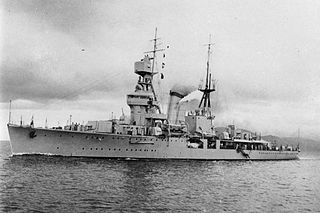
HMS Kandahar (F28) was a K-class destroyer built for the Royal Navy during the 1930s, named after the Afghan city of Kandahar.
A petty officer (PO) is a non-commissioned officer in many navies. In many nations, they are typically equal to a sergeant in comparison to other military branches. Often they may be superior to a seaman, and subordinate to more senior non-commissioned officers, such as a chief petty officers.

In the rating system of the Royal Navy used to categorise sailing warships, a sixth-rate was the designation for small warships mounting between 20 and 28 carriage-mounted guns on a single deck, sometimes with smaller guns on the upper works and sometimes without. It thus encompassed ships with up to 30 guns in all. In the first half of the 18th century the main battery guns were 6-pounders, but by mid-century these were supplanted by 9-pounders. 28-gun sixth rates were classed as frigates, those smaller as 'post ships', indicating that they were still commanded by a full ('post') captain, as opposed to sloops of 18 guns and less under commanders.
Seafaring is a tradition that encompasses a variety of professions and ranks. Each of these roles carries unique responsibilities that are integral to the successful operation of a seafaring vessel. A ship's crew can generally be divided into four main categories: the deck department, the engineering department, the steward's department, and other. The reasoning behind this is that a ship's bridge, filled with sophisticated navigational equipment, requires skills differing from those used on deck operations – such as berthing, cargo and/or military devices – which in turn requires skills different from those used in a ship's engine room and propulsion, and so on.

The Admiralty type leader, sometimes known as the Scott class, were a class of eight destroyer leaders designed and built for the Royal Navy towards the end of World War I. They were named after Scottish historical leaders. The function of a leader was to carry the flag staff of a destroyer flotilla, therefore they were enlarged to carry additional crew, offices and signalling equipment, allowing a fifth gun to be carried. These ships were contemporary with the Thornycroft type leader, distinguishable by their two narrow funnels of equal height, the Thornycroft designs latter having characteristic broad, slab-sided funnels.

HMCS Skeena was a River-class destroyer that served in the Royal Canadian Navy (RCN) from 1931 to 1944. She was similar to the Royal Navy's A class and wore initially the pennant D59, changed in 1940 to I59.

The three Chikuma-class cruisers were protected cruisers operated by the Imperial Japanese Navy. They participated in numerous actions during World War I.
A naval surgeon, or less commonly ship's doctor, is the person responsible for the health of the ship's company aboard a warship. The term appears often in reference to Royal Navy's medical personnel during the Age of Sail.

The master, or sailing master, is a historical rank for a naval officer trained in and responsible for the navigation of a sailing vessel.
Master's mate is an obsolete rating which was used by the Royal Navy, United States Navy and merchant services in both countries for a senior petty officer who assisted the master. Master's mates evolved into the modern rank of sub-lieutenant in the Royal Navy, while in the merchant service they evolved into the numbered mates or officers.
A captain's clerk was a rating, now obsolete, in the Royal Navy and the United States Navy for a person employed by the captain to keep his records, correspondence, and accounts. The regulations of the Royal Navy demanded that a purser serve at least one year as a captain's clerk, so the latter was often a young man working his way to a purser's warrant. He had high status, with an office on the quarterdeck or upper deck on most ships. He was paid at the same rate as a midshipman in 1800, but by 1815 he had almost the same monthly pay as a standing warrant officer. On large ships, he had his own cabin in the gunroom, but on smaller vessels he lived with the midshipmen on the orlop deck.
A surgeon's mate was a rank in the Royal Navy for a medically trained assistant to the ship's surgeon. The rank was renamed assistant surgeon in 1805, and was considered equivalent to the rank of master's mate/mate. In 1807, first-rate would have three, a third-rate two, and frigates and sloops one.
The Standard-type battleship was a series of thirteen battleships across five classes ordered for the United States Navy between 1911 and 1916 and commissioned between 1916 and 1923. These were considered super-dreadnoughts, with the ships of the final two classes incorporating many lessons from the Battle of Jutland.

Ning Hai was a light cruiser in the Republic of China Navy (ROCN) before World War II and the lead ship of her class. She was sunk in the early days of the Second Sino-Japanese War by aircraft from the Imperial Japanese Navy, and her wreck was raised and repaired by the Japanese, re-entering service with the Japanese Navy in the Pacific War as the escort vessel Ioshima (五百島). She was sunk again in September 1944 by a USN submarine.

The Ha-1-class submarine was an early class of submarines of the Imperial Japanese Navy, and were essentially British C-class submarines, which had been imported for evaluation and reverse engineering.